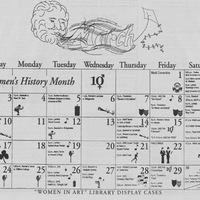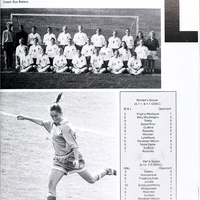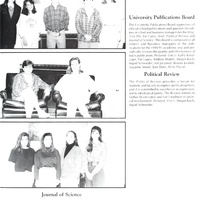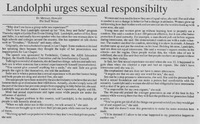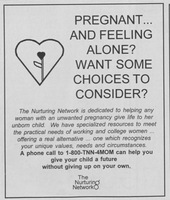The 1990s marked a transformative era at Washington and Lee University, where the portrayal of women pivoted towards empowerment and autonomy. This period saw a significant shift in societal norms, campus culture, and the representation of women in university publications. With the presence of women firmly established in various facets of campus life, the decade embraced a broader and more dynamic view of women's roles.
1990s
Empowerment and Autonomy: Women's Portrayal in the 1990s
Gone were the days when social expectations dictated that women be accompanied by men at campus events. The Women's History Month calendar from 1996 illustrates this transition, featuring events where women took center stage, from sports to academic discussions. This change in portrayal from previous decades signified an acknowledgment of women's independence and equal footing in the social hierarchy of campus life.
The 1990s heralded the inclusion of women's sports, with the Women's Soccer team of 1994 representing a leap forward in the portrayal of female athletes. Far from being sidelined, these women were celebrated for their athletic prowess, as depicted in action shots of players like Allison Warner. Their representation in The 1994 Calyx highlighted their strength, skill, and sportsmanship, emphasizing their importance in university athletics and challenging traditional gender roles.
Sororities gained prominence as communities where women led and thrived. The Student Organizations page from 1991 shows women in leadership roles within the University Publications Board, indicating an environment where female students were taking charge, shaping their social lives, and contributing to the campus's intellectual life. These spaces offered women the chance to assert their identities and challenge stereotypes, embodying the era's spirit of empowerment.
A 1995 article on sexual responsibility in The Ring-Tum Phi underlines the nuanced understanding of consent and sexual education, with speakers like Landolphi urging students to respect their own and others' boundaries. This approach to discussing sexuality represents a mature and progressive perspective, acknowledging the complexity of modern relationships and the importance of personal agency.
In 1998, there were misleading abortion ads targeting students. These ads weren't real reproductive health services but tricks used by certain clinics to convince women to keep their pregnancies. The fact that these deceptive ads appeared on the Ring Tum Phi suggests a contradiction in the university's move toward empowerment and autonomy. Despite seeming more open-minded, allowing such misleading content indicates a hidden tendency to support conservative and possibly sexist ideas.
In the 1990s, Washington and Lee University's publications captured the evolving narrative of women's experiences, moving beyond stereotypes to portray them as autonomous, multifaceted individuals. The university's records from this decade—whether celebrating athletic victories, showcasing leadership, or tackling complex social issues—reflect a commitment to a more inclusive representation. This period set the stage for ongoing conversations about gender equality, as women continued to shape their destinies and make indelible marks on the university's history and culture. However, as evidenced by the presence of deceptive abortion ads targeting students on platforms like the Ring Tum Phi, there remains a paradox within the university's progress. Thus, while the 1990s set a positive trajectory, the ongoing challenge lies in reconciling evolving societal values with persistent regressive attitudes to create a truly equitable and empowering environment for all.
